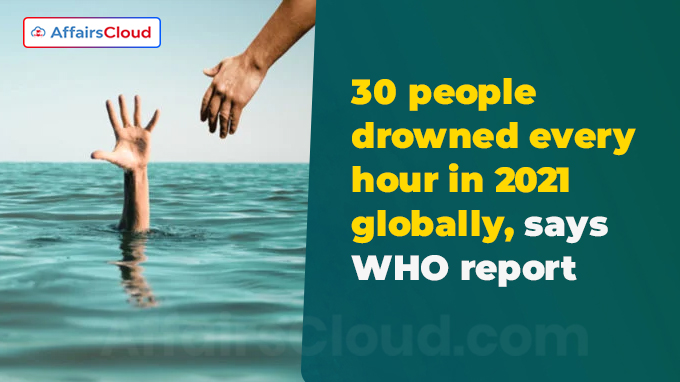 In December 2024, the World Health Organization (WHO) published its first-ever “Global Status Report on Drowning Prevention 2024”, providing a comprehensive analysis of drowning deaths worldwide. The report was released at an event in Geneva, Switzerland and highlights the global burden of drowning, key statistics and strategies for prevention.
In December 2024, the World Health Organization (WHO) published its first-ever “Global Status Report on Drowning Prevention 2024”, providing a comprehensive analysis of drowning deaths worldwide. The report was released at an event in Geneva, Switzerland and highlights the global burden of drowning, key statistics and strategies for prevention.
- According to the report, the drowning death rate has dropped by 38% worldwide since 2000, marking a major health achievement.
- The report reveals that drowning remains a significant public health issue, with over 3 lakh drowning deaths recorded in 2021 alone. The WHO’s South-East Asia Region (includes India) saw 83,000 deaths of the global burden.
Highlights of the Report:
i.This report, developed with input from 139 countries, including India is part of a larger initiative led by the World Health Assembly (WHA) and United Nations General Assembly (UNGA).
ii.The report underscores the importance of multi sectoral collaboration involving various government sectors and non-governmental organizations.
- The initiative aligns with global health priorities and Sustainable Development Goals (SDGs).
iii.The report draws attention to its high mortality rate, particularly in low and middle income countries, which account for nearly 92% of all drowning deaths.
- The WHO aims to use this data to raise awareness, guide prevention strategies, and monitor progress toward drowning prevention goals.
Current State of Drowning Deaths:
i.Global Impact: WHO reports that more than 30 people drown every hour, resulting in an estimated 300,000 deaths annually.
- More than 7.2 million people, mainly children, could die by drowning by the year 2050 if current trends continue.
ii.Regional Breakdown: The WHO South-East Asia Region, which includes India, recorded 83,000 drowning deaths, making up 28% of the global burden.
- The Western Pacific Region was similarly affected with 84,000 deaths.
- The African Region saw the highest drowning death rate, with 5.6% deaths per 1 lakh people.
iii.Declining but Slow Progress: The report highlights that while there has been notable progress in some regions, such as 68% decrease in drowning death rates in Europe, the African region has seen only a 3% decline and the South-East Asia Region only saw a 48% reduction.
Impacts Globally:
i.Progress: The global drowning death rate with WHO’s recommended interventions contributing significantly to these improvements.
- Children, particularly those under the age of 5 are disproportionately affected.
- They account for 24% of drowning deaths globally.
- Young people between the ages of 5 and 29 are also significantly at risk.
ii.Regional Challenges: Progress in drowning prevention has been uneven, with 9 in 10 drowning deaths occurring in low- and middle-income countries.
- In some regions, such as Africa, progress is limited, highlighting disparities in national policies and resources.
iii.Children and Vulnerable Populations: Drowning remains a leading cause of death for children under the age of 5 in many regions.
- Additionally, people with disabilities and those in poverty face heightened risks due to limited access to safety measures and education.
Vulnerable Groups
The report highlights that children and young people are the most vulnerable to drowning.
- Under 5 years: 24% of all drowning deaths globally.
- Ages 5–14 years: 19% of all drowning deaths.
- Ages 15–29 years: 14% of all drowning deaths.
Other points:
i.The South-East Asia region, which includes India, bears a significant portion of the global drowning burden.
- In India, drowning is a major cause of death, particularly among children.
ii.The report emphasizes that the rate of drowning deaths in low and middle income countries is 3.2 times higher than in high-income nations.
- The region has the 3rd leading cause of death for children aged 5–14 years and the fourth leading cause for children aged 1–4 years.
ii.The report stresses that drowning is a preventable tragedy and investing in prevention strategies could save millions of lives by 2050 and without such investments, the economic losses related to drowning could exceed USD 4 trillion.
Key Interventions for Drowning Prevention:
WHO outlines several key actions for drowning prevention that have proven effective:
- Child Safety: Installation of barriers to prevent child access to water and providing safe areas for young children away from water bodies.
- Education and Awareness: Teaching children basic swimming and water safety skills and providing training on safe rescue and resuscitation techniques.
- Community-Based Programs: Strengthening public awareness campaigns, implementing safe boating and ferry regulations, and improving flood risk management.
- Data Collection and Monitoring: Collecting accurate data through civil registration and vital statistics systems to track drowning deaths and enhance prevention strategies.
Key Recommendations for Prevention:
- Public Awareness and Education: Raising awareness about drowning risks, especially in high-burden countries, is critical.
- Government Action: Governments need to enact and enforce legislation for water safety, such as pool fencing and safe transport regulations.
- Training: Implementing national programs to train bystanders in safe rescue and resuscitation techniques is essential.
- Curriculum Integration: Integrating swimming and water safety education into school curriculums, especially for children aged 5–14 years.
- Preschool Care: Ensuring the availability of safe, supervised environments for young children.
Note: World Drowning Prevention Day is observed every year on 25th July across the world to raise awareness and accelerate action on global drowning prevention.
About World Health Organization (WHO):
Director General(DG)- Tedros Adhanom Ghebreyesus
Headquarters- Geneva, Switzerland
Established- 1948



